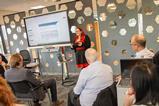
Organisations have a wealth of employee data, almost at their fingertips: from basic demographical information to more in-depth personal data such as health and fitness, absence records, or health insurance and group risk claims. This data plays an important role in improving employee wellbeing and resilience, providing strategic direction based on the health risks that exist within an organisation. But how should employers be using this data to inform their health and wellbeing strategies?
Firstly, employers should focus on the purpose of their data collection; there needs to be a clearly defined use-case for collecting employee data, even if it is anonymised and aggregated health data. Aon’s Rising resilient report, published in March 2020, shows that 80% of employers agree that wellbeing is beneficial for their organisations in the long run. However, it also found that only 30% of employees said they were resilient. Data from Aon's whitepaper, Unlocking the value of employee data, published in September 2022, shows that employers which build resilient workforces benefit from healthier employees (+19%), lower employee turnover (+42%), and higher productivity (+42%), also impacting company performance with client satisfaction, profit, innovation, brand image and retention.
The research is clear; understanding and improving employee health can drive a positive commercial impact.
Connecting the data dots
However, data collection comes with challenges. Employers may not always be able to leverage available data, often due to siloed data architecture or lack of resource to support complex cross-platform data analysis.
So-called disparate data, where data is separate and distinct from each other, can create challenges in aggregation and analysis. This can be further compounded by data which is spread across geographical boundaries, regional structures within organisations, or inconsistencies in data structure which makes reliable comparative analysis impossible.
Having one global platform can help address these issues; providing a single and consistent source of employee health data which can be accessed via an in-built analytics dashboard. Using one health and benefits platform can also be beneficial for integrating other people-related systems, as it reduces the number of data connections that need to be made. Supported by automated implementation processes, today’s benefits technology can also reduce the person hours required for setup, and improve overall data quality.
Understanding the available data
Employers are seeking to work with providers which have the capabilities to help them understand the data available within their business, and deliver customised analytics that can be carried out regardless of geographical, or other, boundaries. In addition to this, organisations are increasingly seeking to work with providers which can offer a solution that enables secure management of employee data through online benefits platforms, and we are seeing a shift as leading consultancies invest further in these capabilities and infrastructure to support this evolving client need.
This was the case for one particular global investment firm which needed a centralised hub for employee health data across 16 locations. At the front-end, Aon's The Benefits Solution enabled employees to manage their own health, wellbeing and retirement plans, while at the back-end it provided rich aggregated data of employee health as well as helping to identify the most popular benefits and those which were underutilised across each of the locations. Utilising data in this way also helped provide a picture of workforce health, not just as a one-off but on a regular basis, providing crucial insight on the effectiveness of health and wellbeing strategies, and delivering a quantifiable return-of-investment.
Creating quantifiable goals
Once organisations have started to understand their data, they need to set clear goals and key performance indicators (KPIs) around the outcomes they would like to achieve. Competitor and peer benchmarks can help support goal development; perhaps absence rate is higher than industry average, or health benefits take up is lower than in comparative organisations.
Ideally, these goals must be both quantifiable and aligned to key interventions; this will allow benefits spend to be directly attributed to impact. We often hear from employers that determining return-on-investment of benefits spend is a key challenge, and yet there is a huge demand to measure effectiveness. Better data, clear dashboards, and quantifiable goals all determine whether employers can attribute spend impact against outcome.
Data to drive continuous strategic improvement
Regular reviews of employee health data can help identify trends and flag any potential or emerging health issues in individual organisations. With medical costs predicted to rise globally in 2023, employers are starting to take preventative action to address health risks before they become claims on their private medical insurance or raise workforce absenteeism costs. In order to adopt this approach, employers need to understand the health risks facing their workforce and use heath data to target their interventions and redirect spend to prevention to avoid significantly higher treatment costs. Having the right data can tell an organisation what the key population health risks are for their workforce and enable them to make better, more informed decisions.
Health and wellbeing strategies cannot be truly effective without the data on the current and emerging health risks within an employee population. But, data collection should not just be a one-time collection; regular data monitoring is a key part of any strategy, as employees’ needs change, the data will reflect this evolution.
Andrew Krawczyk is commercial leader of health solutions for the Europe, Middle East and Africa region at Aon
Read also:
How employee data can build a resilient workforce
South Cambridgeshire District Council uses surveys and data to inform wellbeing strategy



































